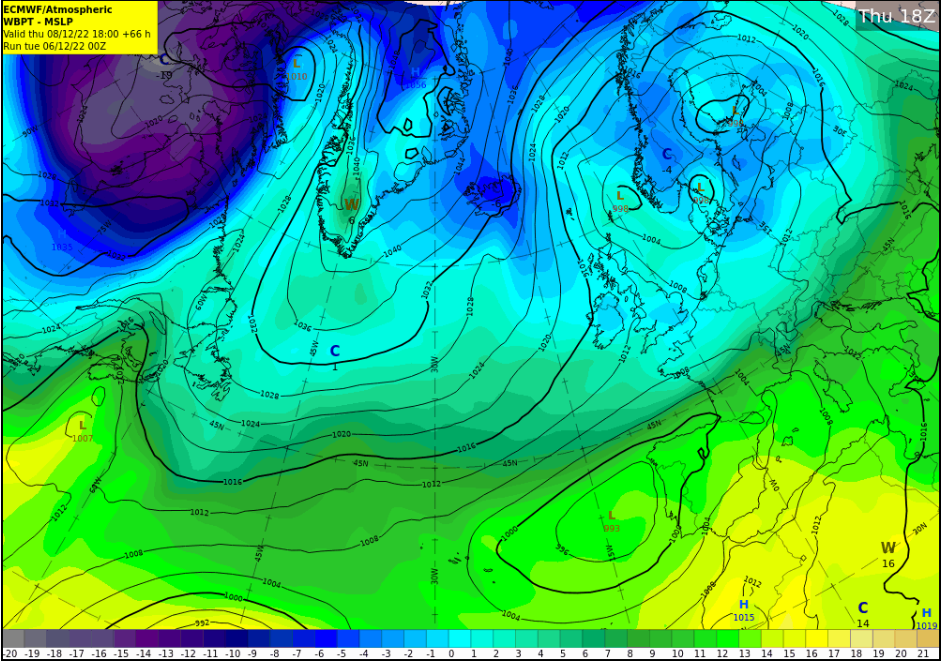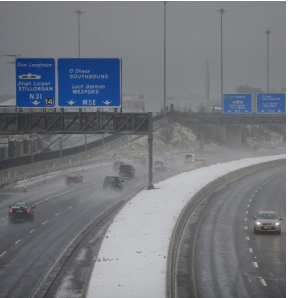An Artic airmass will bring sharp to severe frosts with ice on footpaths and roads. Showers of hail, sleet, snow and freezing rain are likely with fog and possibly freezing fog towards the weekend.
Meteorologist Andrew Doran Sherlock explains “the most severe impacts will be on driving conditions which could be treacherous in places on Thursday morning, particularly during commute times”

Airmass chart for Thursday 8th December showing a cold (blue) airmass extending southwards over Ireland.
Very cold conditions will set in as an Arctic airmass moves southwards, extending over Ireland. Daytime temperatures will struggle to reach the low single figures. Air temperatures will widely drop to -4°C or -5°C at night, dropping down lower locally, with ground temperatures expected to fall further. A status yellow low temperature/ice warning has been issued for Thursday with further warnings likely to be required for the following days.
Wintry showers with falls of hail, sleet and snow are expected which will lead to dangerous conditions on paths and roads. Freezing rain is also possible, resulting in black ice.
Mist and fog will also be a feature of the nights and with very slack winds over the weekend, widespread and dense fog is expected, lingering in some parts through much of the day. Freezing fog is also a possibility.
Be Winter Ready
For information on winter weather preparation, please consult www.winterready.ie
Freezing Rain & Black Ice
Water droplets don’t necessarily freeze immediately when the air temperature falls below 0°C as they need freezing nuclei to convert to ice particles. Rain droplets that exist below 0°C are said to be supercooled. Freezing rain is where these supercooled water droplets fall to the surface causing significant disruption and hazardous conditions. While unusual in Ireland, freezing rain does sometimes occur, converting to black ice when it hits a surface. Black ice is especially dangerous as it is invisible and can be mistaken for wet surfaces – leading to treacherous conditions on roads and paths. Freezing rain can also lead to ice build-up on car windscreens impairing visibility.
Fog & Freezing Fog
Fog is essentially thick, low lying cloud composed of tiny water droplets (1 million fog droplets is equivalent to 1 rain droplet) suspended near the Earth’s surface where visibility is reduced below 1km. The reduced visibility is a major hazard for those travelling on or near roads. Freezing fog is where the water droplets are supercooled, and while suspended in the air, can be converted to ice upon contact with a surface such as a car windscreen. This leads to further hazardous driving conditions.
Climate Statistics
Irelands’ coldest day in December occurred on Christmas day the 25th December 2010. The air temperature at Straide, County Mayo dropped to -17.5°C and 11cm of snow was observed at this station that morning.
Although it is too early to say that 2022 will be Ireland’s warmest year on record yet, what would we need for this to be a record-breaking warm year? And will this cold spell stop Ireland having its warmest year on record?
The average daily maximum temperature we expect in Ireland in December is generally in the range of 7 to 10°C and the average daily minimum temperature we expect in December in Ireland is generally in the range of 2 to 5°C.
According to Met Eireann’s latest statistics, Ireland would have to have a December monthly mean temperature of 4.05°C or below to not have the warmest year on record.
A December monthly mean temperature of 4.05°C has only happened 7 times in 123 years, the last couple of times being Dec 2009 and 2010, when it was 4.01°C and 1.44°C respectively.
For the most accurate and up to date forecast for your area on the Island of Ireland go to met.ie. The latest weather advisories and warnings for Ireland are on the Met Éireann Warnings page. These services and more are available on our free app – available from the App store for iPhone, and Play store for Android.
